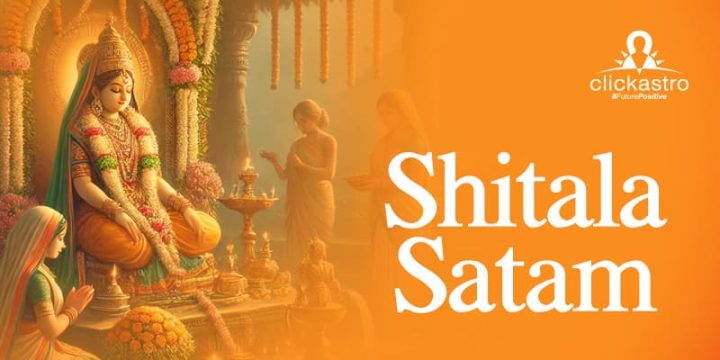Introduction
Shitala Satam is a revered festival dedicated to Goddess Shitala, known for granting protection from diseases like measles and chickenpox. It is celebrated primarily in the states of Gujarat, Rajasthan, and Uttar Pradesh. Shitala Satam is equivalent to Basoda and Sheetala Ashtami observed in northern India after
Holi. The festival falls a week ahead of
Krishna Janmashtami, typically in August. Devotees believe that worshipping Goddess Shitala can bring relief from various ailments and ensure the well-being of their families, especially children. The rituals involve fasting, offering prayers, and performing
specific pujas. Shitala Satam not only reflects the rich cultural heritage but also underscores the importance of health and protection in traditional beliefs.
Date and Time for Shitala Satam 2024
- Date: Sunday, August 25, 2024
- Puja Muhurat: 05:56 AM to 06:50 PM
- Duration: 12 Hours 56 Mins
- Saptami Tithi Begins: 05:30 am on August 25, 2024
- Saptami Tithi Ends: 03:40 am on August 26, 2024
The Significance of Worshipping Maa Shitala
The worship of Maa Shitala holds profound importance in regions prone to infectious diseases. Goddess Shitala is often depicted carrying a broom and dustpan, symbolizing the eradication of disease and the purification of the environment. Devotees turn to Maa Shitala for relief from various ailments, with a particular focus on diseases like smallpox, chickenpox, and measles. The rituals performed on Shitala Satam are designed to honor the goddess and seek her blessings for health and well-being.
On this day, devotees engage in practices that symbolize cleanliness and purity. They fast, offer prayers and perform specific pujas to invoke the goddess’s healing powers. No food is prepared on the day as it is believed Maa Shitala likes to rest and roll in the cool ashes of the unlit fireplace on this day. So, food that is to be consumed on this day is prepared on the day before.
Shitala Satam Puja Vidhi: Detailed Preparation and Rituals
Shitala Satam, dedicated to Goddess Shitala, is marked by various activities that symbolize purity, respect, and a plea for the goddess’s blessings. The rituals are carefully performed to honor Shitala Mata and seek her protection from diseases. Here’s a detailed look at the preparation and rituals involved in Shitala Satam puja vidhi:
Morning Rituals
Devotees wake up before sunrise and take a thorough bath, signifying physical and spiritual cleansing. This act is essential as it prepares the body and mind for the day’s fasting and rituals. In many regions, devotees make their way to riverbanks, lakes, or other natural water bodies to perform these ablutions. At the riverbank, an idol of Shitala Mata is placed and adorned with turmeric, sandalwood paste, and vermillion. The yellow of turmeric and the red of vermillion are considered auspicious and are integral to the worship rituals.
Puja Procedure
After the idol has been properly prepared, it is set on a red cloth. The color red symbolizes auspiciousness, purity, and the goddess’s power. The idol is given a holy dip in water, symbolizing purification and sanctity. The main puja begins with the Shodashopachara, a series of sixteen offerings that include items such as water, flowers, incense, lamps, and food. This ritual ensures that every aspect of hospitality and reverence is covered in the worship of the goddess. During this time, devotees recite the Sheetla Ashtakam and other sacred scriptures, invoking the goddess’s presence and blessings.
Cooking Restrictions
One of the most distinctive aspects of Shitala Satam is the prohibition on cooking fresh food on the day. Instead, all food is prepared the day before, known as Randhan Chhath. This tradition stems from the belief that the goddess should not be disturbed by the heat and smoke of cooking fires. It is thought that on Shitala Satam, the goddess rests and rolls in the cool ashes of the hearth. Therefore, the hearth is left undisturbed, and no fresh food is cooked. The food prepared at Randhan Chhath includes various traditional dishes that can be consumed cold. These might include items like laddoos, thepla (a type of flatbread), sweet dhebra, paratha, and various types of shaak (vegetable preparations). This pre-cooked food is shared among family members and offered to the goddess during the puja.
Offerings and Lighting
Devotees light lamps (diyas) and incense sticks in front of the goddess’s idol, creating a serene and sacred atmosphere. The light from the diyas symbolizes the dispelling of darkness and ignorance, while the incense represents the spreading of divine fragrance and purity. The elderly members of the household narrate the legends and significance of Shitala Mata. These stories reinforce the cultural and spiritual values associated with the festival. Listening to it helps devotees understand the importance of the day and the goddess’s benevolent nature.
Shitala Satam is not just a personal observance but a communal event. Families often come together to perform the rituals, and neighbors may join in the celebrations. This collective participation fosters a sense of unity and shared devotion. In regions like Rajasthan, the festival is marked with great fervor, including fairs and musical programs. Such events provide a platform for communal worship and celebration, strengthening social bonds and cultural identity.
The Vrat Katha
The Vrat Katha or legend associated with Shitala Satam is a tale of devotion, faith, and divine intervention. According to mythology, King Indradyumna and his queen Pramila were devout followers of Shitala Mata and observed Shitala Satam with unwavering devotion. This tradition of worship and fasting was passed down through their family. Their granddaughter, Shubhakari, who was married to Prince Gunvan, continued this practice with the same fervor and dedication.
One auspicious day, Shubhakari decided to observe Shitala Satam Vrat and, as part of the rituals, went to the lake with her friends to perform the necessary puja. However, during their journey, they lost their way and found themselves unable to locate the sacred site. In their moment of distress, an old lady appeared and offered to help them. She guided the group to the lake and assisted them in conducting the puja according to the prescribed rituals.
Impressed by their dedication and the proper conduct of the rituals, Shitala Mata manifested herself through the old lady. The goddess, pleased with Shubhakari’s devotion, granted her a boon. Shubhakari, with profound gratitude, accepted the blessing but decided to use it only when truly needed.
On their way back to the kingdom, Shubhakari and her friends encountered a sorrowful scene: a poor Brahmin family mourning the death of a family member due to a snake bite. Moved by their grief, Shubhakari prayed to Shitala Mata and invoked the boon she had received. Miraculously, the dead Brahmin was brought back to life.
This miraculous event underscored the significance of observing Shitala Satam Vrat. The legend of Shubhakari’s unwavering devotion and the divine blessing she received has been passed down through generations, inspiring countless devotees to honor Shitala Mata with the same devotion and faith.
Benefits of Observing Shitala Satam Vrat
Observing Shitala Satam Vrat is believed to bestow numerous health benefits upon devotees. The primary belief is that worshipping Maa Shitala can protect individuals and their families from contagious diseases such as smallpox, chickenpox, and measles. Women, in particular, fast on this day to ensure the good health and well-being of their children. The act of fasting and performing the puja is seen as a form of penance and devotion that pleases the goddess, who in turn grants her blessings of health and safety.
Additionally, Shitala Satam emphasizes the value of community and charity. It is customary for families to distribute food to the poor, reflecting the festival’s underlying themes of compassion and social responsibility. Sharing meals with friends and neighbors also fosters a sense of unity and collective well-being.
Shitala Satam Celebration Across India
Shitala Satam is celebrated with varying customs and fervor across different regions of India, reflecting the rich variety of cultural practices and beliefs.
Gujarat:
In Gujarat, Shitala Satam is observed on the 7th day of the Shravan month, which can either be Shravan Sud 7 (the waxing phase of the moon) or Shravan Vad 7 (the waning phase of the moon). The preceding day, known as Randhan Chhath, is dedicated to cooking food for the following day, as it is forbidden to cook on Shitala Satam. The cooked food is then shared among family, friends, and neighbors, symbolizing community bonding and continuity of tradition. Devotees in Gujarat wake up early, bathe, and engage in elaborate pujas at home or temples, offering prayers and food to the goddess.
Rajasthan:
In Rajasthan, the celebration of Shitala Satam is marked by vibrant fairs and musical programs, which underscore the cultural significance of the festival. The community gathers to participate in various cultural activities, including traditional music and dance performances. Temples dedicated to Shitala Mata are beautifully decorated, and large crowds come together to offer their prayers and seek blessings. The festival is a time for social gathering and cultural expression, highlighting the communal spirit and rich heritage of the region.
Other Regions:
While Gujarat and Rajasthan are notable for their distinct celebrations, other parts of India, including Uttar Pradesh, also observe Shitala Satam with similar reverence. In these regions, the rituals may vary slightly but the core practices of fasting, avoiding fresh cooking, and performing pujas remain central to the observance.
Conclusion
Shitala Satam is a profound expression of faith in Goddess Shitala, celebrated with great devotion in the western regions of the country. This festival not only reinforces the cultural heritage and spiritual beliefs of millions but also highlights the protective and healing powers of the goddess. Devotees observe fasting, engage in prayers, and partake in community sharing, all of which serve as acts of devotion aimed at seeking the blessings of Shitala Mata for good health and protection from diseases like smallpox, chickenpox, and measles. By adhering to traditions such as cooking food a day in advance and refraining from lighting fires, worshippers demonstrate their reverence and respect for the goddess. This age-old festival fosters a sense of community, compassion, and continuity. Through these collective acts of faith and devotion, the festival embodies the enduring power of tradition and the deep-rooted belief in divine intervention and protection.








